Parents are trading their paychecks for back-to-school essentials as students prepare to bid farewell to their summer adventures and return to the classroom.
During the 2023 back-to-school season, the average K-12 household spent $890. Households with college-bound students spent $1,367. The trend for 2024 promises to be similar.
Discover ten data-backed back-to-school retail tips and trends to attract more customers before school shopping begins.
Back-to-School 2024 Shopping Will Be the Biggest Yet
Consumers plan to spend at record levels this back-to-class season. In 2023, American families spent $42.3 billion on K-12 back-to-school shopping and $36.4 billion on back-to-college shopping.
Back-to-school and back-to-college spending combined may total $189.7 billion in 2028.
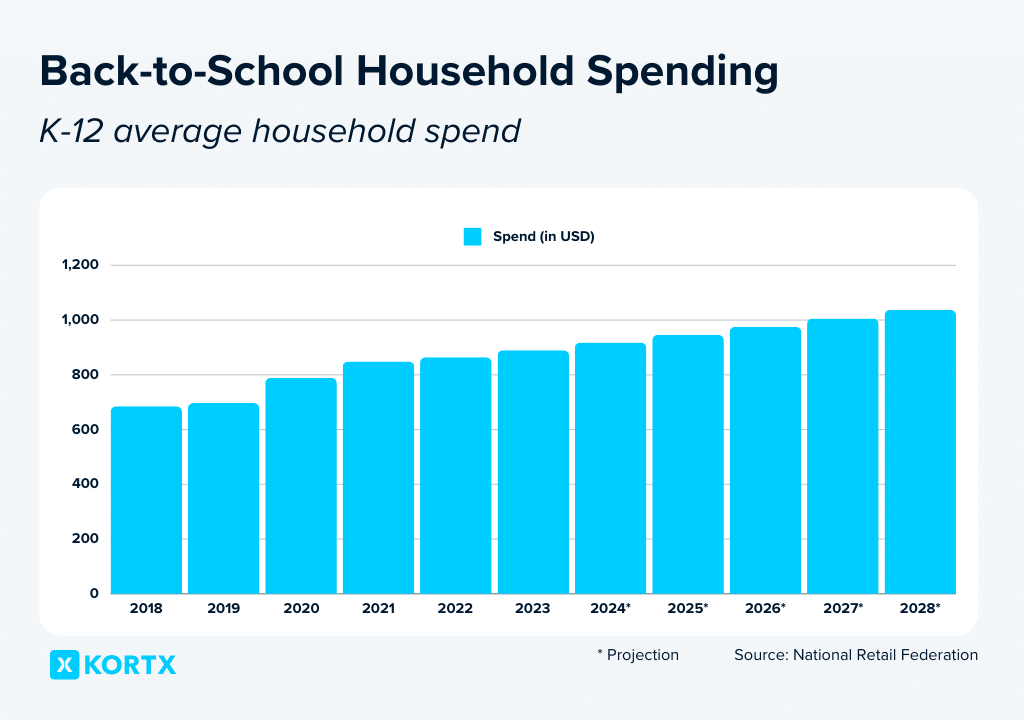
When Does Back-to-School Shopping Start?
Back-to-school sales start in early July, with over half of consumers (55%) beginning their shopping at this time. Parents often buy essentials like school uniforms later in the summer to accommodate children’s growth spurts.
This early July surge includes shoppers eager to spread their budgets over a longer period of time due to rising school item costs. Budget-conscious parents and caregivers aim to find the best deals over the extended shopping period.
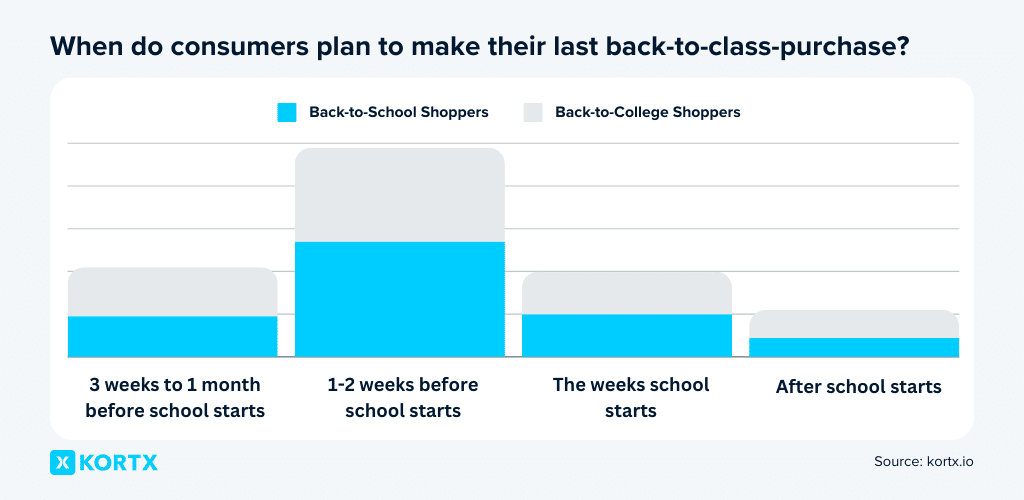
By early August, many families have completed about half of their shopping, focusing on supplies, clothing, and accessories. Over a quarter of all consumers and 34% of college students continue shopping for bigger-ticket items like electronics.
Retailers and marketers should plan their campaigns by mid-May or June, launching as schools start closing for summer break.
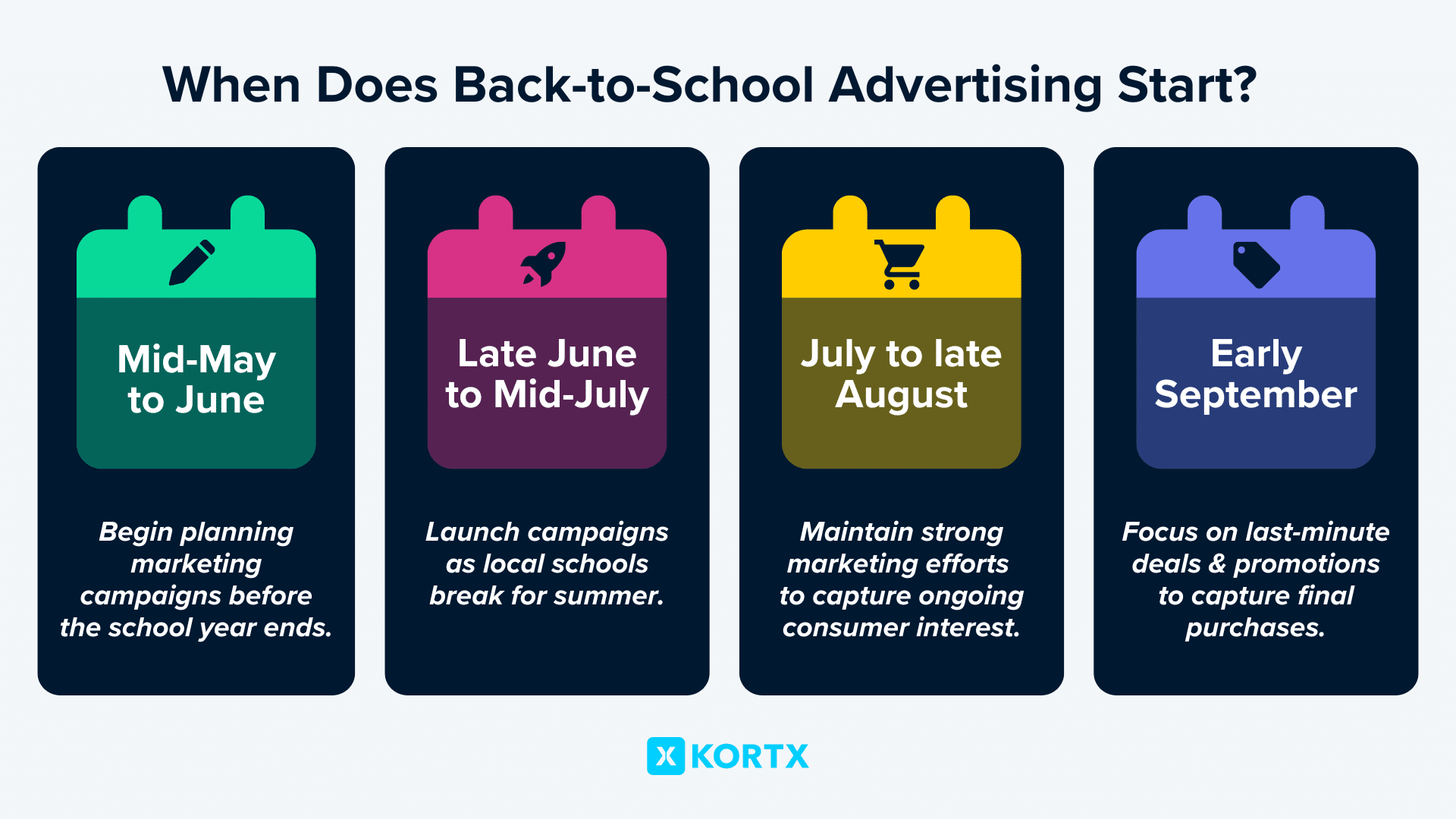
What are Back-to-School Parents Buying?
K-12 parents and guardians commonly purchase clothing, accessories, and basic school supplies for their children, such as books, pens, and backpacks.
In 2023, school-related electronics surged, with approximately 70% of U.S. parents buying computer equipment (primarily laptops, tablets, and cell phones). This represents a 15% increase from ten years ago.
Preconfigured school supply kits are also popular due to their cost-effectiveness and convenience, with 46% of shoppers choosing them.
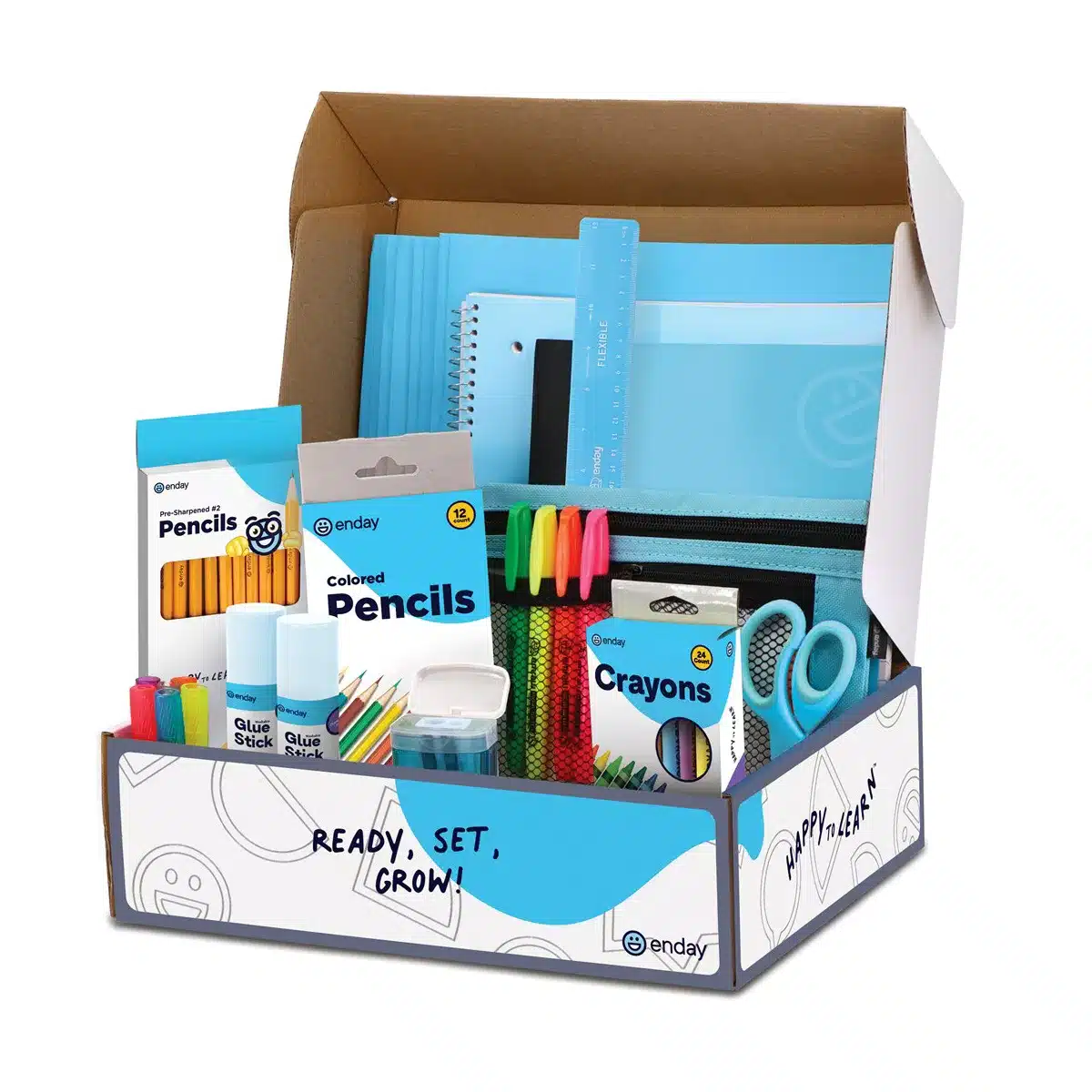
Preconfigured school supply boxes have all the essentials students need for back-to-school.
How about Back-to-College Parents & Students?
Back-to-college spending on clothing and accessories has fluctuated, peaking in 2023 with an average planned expenditure of $182 per consumer.
Total spending on back-to-college items reached a record $94 billion in 2023, encompassing clothing and accessories, electronics, food supplies, personal care products, and dorm furnishings.

How are Back-to-Class Shoppers Buying?
Consumers will use a mix of channels to make their shopping trips hassle-free and convenient.
For all back-to-class shoppers, the top destinations are online (online-only like Amazon and retailers like Target), department/big box stores, and discount stores. 41% of parents plan to split their back-to-school spending evenly between online and in-store purchases.
Omnichannel retailing supports a seamless experience across in-store, online, and app-based shopping.
Gen Z, a significant college student demographic, heavily influences this trend. 60% of Gen Z discover new products on social media, and they’re twice as likely as the general consumer to purchase them.
10 Back-to-School & Back-to-College Marketing Ideas for 2024
As the 2024 back-to-school season approaches, marketers should refine their strategies to capture the attention of budget-conscious consumers.
Here are key marketing strategies to enhance your campaigns, utilizing an omnichannel retail approach tailored to current trends and consumer behaviors.
1. Start Early & Align Timeline With Purchase Behavior
Early engagement allows you to capture the attention of early bird shoppers and stay ahead of competitors. More than half of consumers start their back-to-school shopping in early July. Marketers should launch campaigns well before this peak period, from mid-May to early June.
By early August, back-to-school and college shoppers typically have completed about half of their shopping. At the start of summer, they focus on buying supplies and clothing, whereas closer to the school year, they tend to purchase bigger-ticket electronics and accessories.
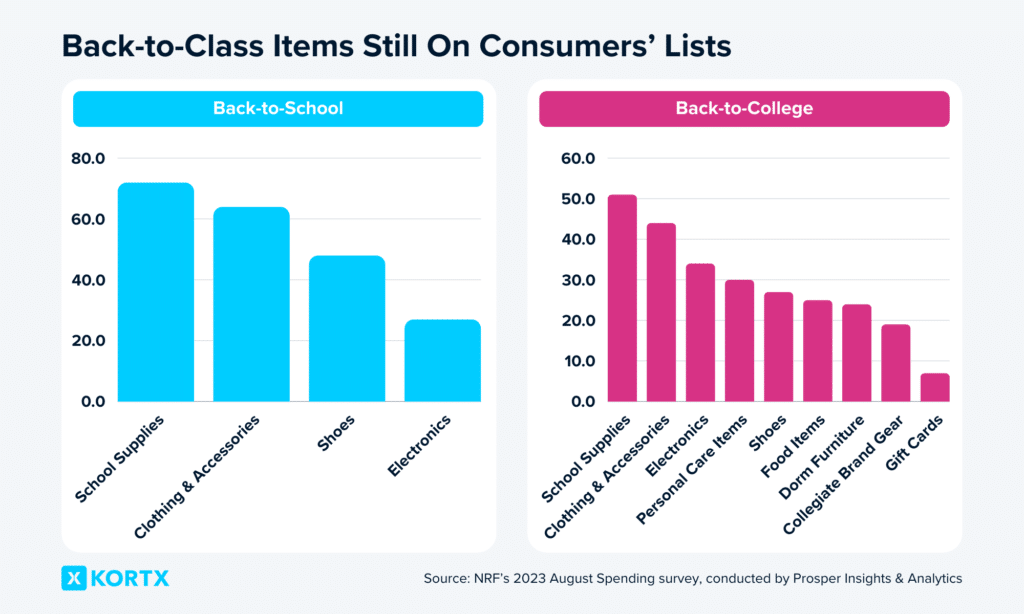
Back-to-class items that are still on consumers’ lists by mid-August.

💡 Takeaway Tip
Launch your back-to-school marketing campaigns well in advance, ideally from mid-May to early June, to engage early bird shoppers and align with consumer purchase behavior.
📚 Related article: Omnichannel Retailing: How to Meet Your Customers’ Needs
Learn why an omnichannel marketing approach improves customer satisfaction and boosts your company’s sales.
When do you start shopping for back-to-school supplies for your kids?
“For our family, back-to-school mode usually starts ramping up around early August when schools begin sending out schedules and reminders for the upcoming year. This is typically when we kick into gear with buying new clothes, supplies, and other odds and ends to prep for the fall.”
2. Build Your Back-to-School Audience Personas
Audience personas represent segments of your target audience and include specifics like age, education level, shopping preferences, and lifestyle. For back-to-school campaigns, focus on your most likely buyers: parents, college students, and educators.
Understanding audience personas involves integrating various data sources to create a detailed profile of your target consumers for back-to-school marketing campaigns:
- Demographic Information: Collect age, gender, income levels, and other basic demographics to tailor content and messaging specifically for groups like parents, college students, or educators.
- Shopping Preferences and Habits: Analyze past purchasing behaviors to understand preferred product types, shopping periods, and buying channels.
- Device Usage Data: Identify all devices the target audience uses, from smartphones to laptops, to determine the best platforms to deliver your ads.
- Engagement Metrics: Use data on previous ad engagements and interactions with your brand.
💡 Takeaway Tip
Craft detailed audience personas to tailor your back-to-school marketing campaigns and resonate with your target consumers’ needs and preferences.
KORTX Intelligence Audience Profile: The Budget-Conscious Mom

Demographics:
- Age: 30-45
- Gender: Female
- Total Household Income: $75,000 to $99,999
- Marital Status: Married
- Number of Children: 2
Preferred Shopping Channels: Primarily shops online, especially at big-box stores like Walmart, Target, and Amazon, but also visits department and discount stores like dollar stores.
Shopping Behavior:
- Early Shopping: Starts shopping during mid-July to capture early deals.
- Pricing-Focused: Acutely aware of rising prices due to inflation, leading to a heightened focus on getting the best value for money spent, like off-brand products.
- Social Media Interaction: Influenced by promotions and products shared on social media.
Find Your Ideal Back-to-School Customers.
Our expert strategists analyze your brand, audience, and competition, delivering data-driven recommendations for your back-to-school campaigns.
3. Enhance Price Transparency & Value Proposition
In response to economic pressures, over 40% of U.S. consumers are doing more comparative shopping online for back-to-school supplies.
Plus, over 70% of consumers continue to prioritize price and quality, suggesting that attractive loyalty programs and high-value products are important this year.
Consider the following strategies to enhance price transparency:
- Highlight Price Comparisons: Enable easy price comparisons on your site with competitor pricing tools or links to comparison websites.
- Promote Value Packs & Bundles: Sell discounted bundles of popular back-to-school items to attract budget-conscious shoppers without sacrificing quality. 46% of parents are expected to purchase pre-configured kits this year.
- Enhance Loyalty Programs: Enhance loyalty programs with back-to-school specials, offering extra discounts, points, or exclusive deals.
- Customized Wish Lists & Registries: Implement tools that allow college students to create and share personalized wish lists or registries.
- Localized Offers: Customize promotions to fit local market conditions and preferences.
The goal is to meet the needs of your price-sensitive shoppers while still promoting the quality and value of your educational products.
How is consumer behavior changing amid inflation?
“Even though consumers plan to spend more on school and college-related items this year, they are still looking to find the best value and deals. Consumers are stretching their dollars by comparing prices, considering off-brand or store-brand items, and are more likely to shop at discount stores than last year.”
Example: Amazon’s Randall Park Ads & Deal Days
Amazon’s back-to-school campaign, featuring Randall Park, promotes savings on discounted items, targeting budget-conscious parents.
Early Prime Day deals also hint at popular products for the upcoming holiday season. Target Circle offers 20% off a total shopping trip. Their custom registry tool, similar to Amazon lists, allows students to easily add products to their wish list and share them with their parents.
💡 Takeaway Tip
Given higher-than-expected inflation in Q1 2024, consumers are likely to remain cost-conscious. Retailers should prioritize value in their marketing messages and reinforce user-friendly loyalty programs.
4. Closely Watch Competitor Pricing Strategies
As shoppers become more attentive to options like private labels or brand comparisons, monitoring your competitors’ pricing can help you adjust your pricing strategy.
Leverage price tracking tools and software that monitor changes in pricing and promotions across various platforms in real-time. Tools like Price2Spy, CamelCamelCamel (for Amazon products), and Keepa can provide automated alerts and detailed reports on competitor pricing activities.
Invest in market research reports and industry analyses that provide insights into pricing trends and strategies in your sector. Companies like NielsenIQ and Kantar offer detailed consumer and market insights that can help understand broader market behaviors. Additionally, consider implementing price-matching policies to stay competitive and build customer loyalty.
Keeping a database of your competitors’ pricing history over time can help anticipate future pricing changes and understand seasonal trends.
💡 Takeaway Tip
Monitor your competitors’ pricing strategies closely and utilize price tracking tools and market research reports to stay informed about pricing trends and adjustments in your sector.
Why should consumers watch their competitors’ pricing strategy?
“As prices increase across the total store, shoppers are now starting to pay a little bit more attention to things like private label or brand comparisons, starting to track your competition, if you’re not already, to see what they’re doing with price is going to be really important. Make sure you’re managing any of the gaps between you and either branded or private label competition.”
5. Broaden Reach with In-Store Inclusivity
With 15% of all public school students receiving special education services, embracing inclusivity meets a growing demand for accessibility.
Every morning from 8 am to 10 am, Walmart offers sensory-friendly hours for those with sensory disabilities. The lights are dimmed, the music is turned off, and the screens display static images.
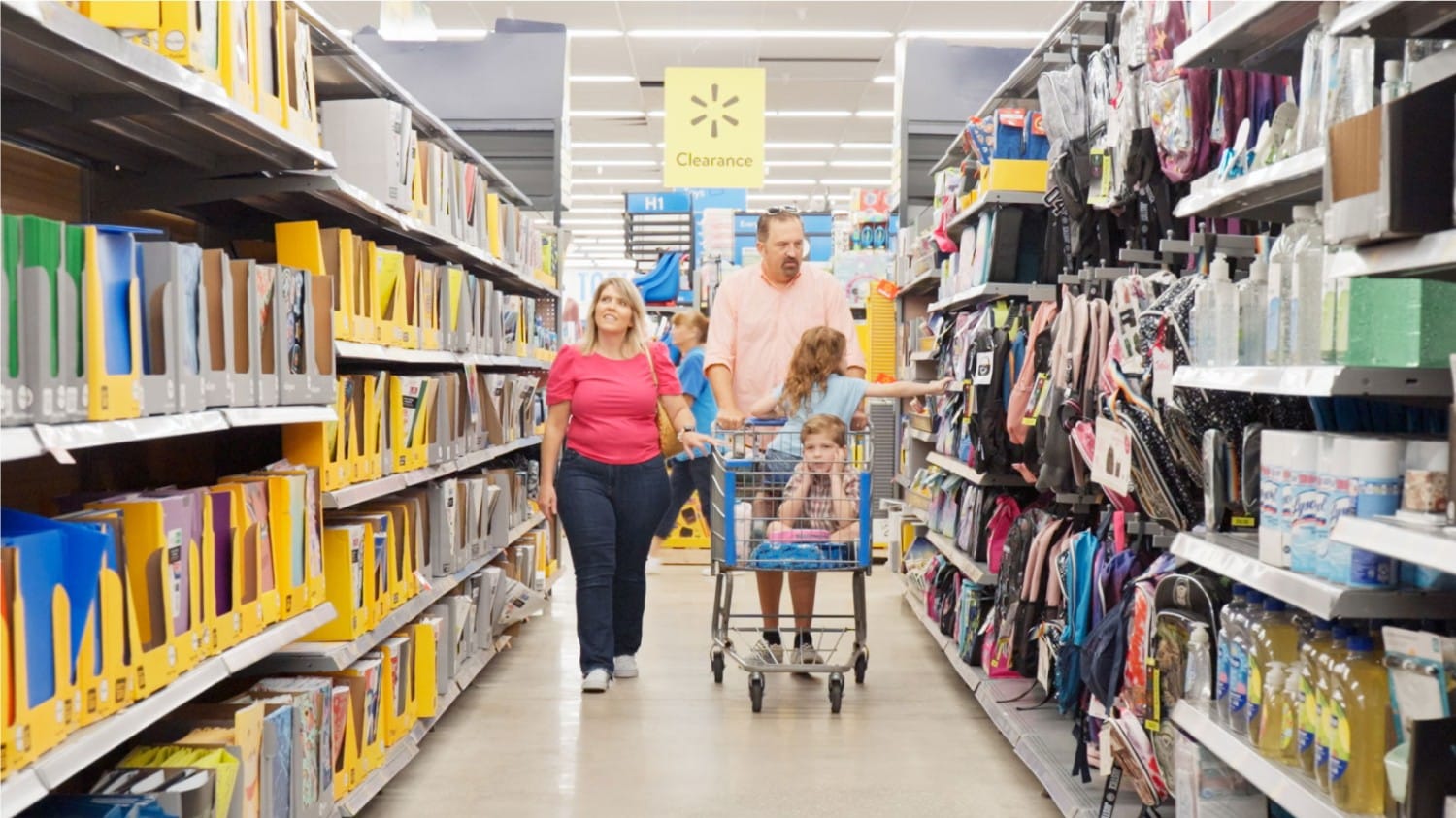
Walmart’s sensory-free experiences were originally only on Saturday mornings, but they became so popular that they were expanded to every weekday.
Beyond inclusive shopping hours, incorporate people with disabilities in your marketing. Only 1% of ads feature Americans with disabilities, yet they represent an active consumer base. Brands can integrate depictions and life experiences with a disability without making it the central focus, helping break down social stigmas and increasing visibility.
💡 Takeaway Tip
To meet the increasing demand for accessibility and inclusivity, integrate people with disabilities into your marketing efforts beyond inclusive shopping hours.
6. Transform In-Store Experiences to Extend Beyond Purchasing
Create environments that encourage foot traffic by balancing shopping with learning and participation.
Here are some back-to-school marketing ideas to encourage in-store engagement other than shopping:
- In-Store Workshops and Demos: Host educational programs similar to Lowe’s DIY-U, such as budgeting workshops for parents or tech tutorials for students. Tailor events to the local community’s needs to attract relevant crowds.
- Enhanced BOPIS (Buy Online, Pick Up In-Store) Integration: Offer seamless BOPIS experiences. Provide product demos or quick tutorials for picked-up items, turning pickups into engaging visits.
- Pop-Up Experiences: Create pop-up events to engage customers, gain exposure, and gather insights for potential permanent locations.
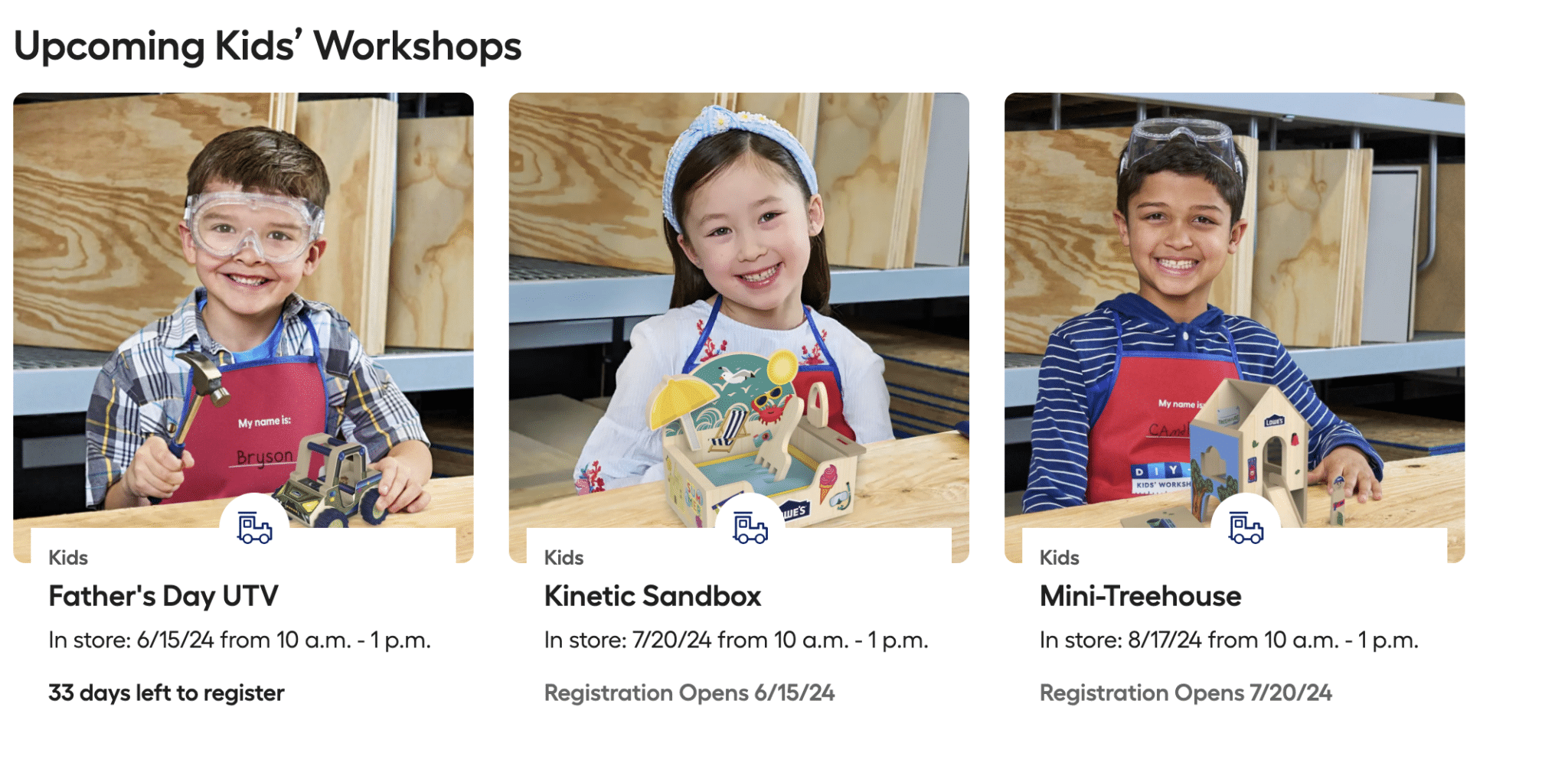
Lowe’s DIY-U program targets homebuyers and their kids.
💡 Takeaway Tip
Enhance in-store engagement by hosting workshops and demos tailored to your local community’s needs, fostering a learning environment that complements the shopping experience and attracts relevant crowds.
Would you ever participate in back-to-school workshops or events at a retailer if they offered a discount on supplies?
“Sure, I would participate in a back-to-school workshop if they offered a discount; those supplies add up so quickly. It would depend on the length of time, though; time is money! I would say (something like) 30 minutes for a 30% discount seems fair.”
7. Incorporate Cross-Device Targeting
The average US household, including both parents and students, owns 17 connected devices. Cross-device targeting allows you to deliver consistent and relevant marketing messages across multiple devices.
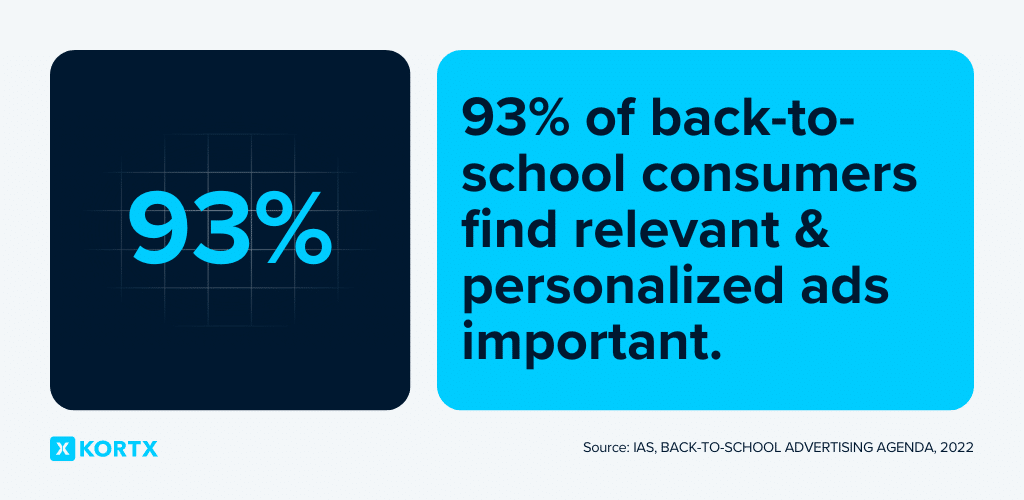
It also provides a more accurate measurement of conversion paths, helping you understand how specific devices and ads affect the final purchase decision.
Why is deterministic cross-device targeting best, and how can a device graph help in back-to-school campaigns?
“With a deterministic method (device graph), marketers can better understand user behavior across different platforms. With probabilistics, marketers can make educated guesses about device ownership. Although a device graph can cost more, its accuracy leads to more successful campaign outcomes.
The accuracy provided by a device graph is particularly valuable for back-to-school campaigns. By identifying the various devices used by parents and students, marketers can tailor their messaging to suit the preferences and habits of different audience segments. For example, one display ad sent to a parent’s device can focus on the price and value of an item, like clothing, while one for students can appeal to individuality and self-expression.”
In Q1 2024, smartphones accounted for over three-quarters of retail site visits and generated roughly two-thirds of online shopping orders. Desktop computers generated just 23% of retail website traffic but represented 34%of all purchases in the US.
Cross-device targeting reaches parents, teachers, and students at all stages of the funnel, creating a cohesive story across channels like display, online video (OLV), connected TV (CTV), Over-the-Top (OTT), audio, and DOOH.
💡 Takeaway Tip
Integrate cross-device targeting into your back-to-school campaigns to deliver consistent messaging across multiple devices. This enhances conversion tracking accuracy and tailoring messages to different audience segments across various channels.
8. Create Engaging Rich Media & Interactive CTV Ads
Rich media ads use interactive and dynamic visuals, such as text, video, images, audio, and animation, to grab the audience’s attention. This adaptability makes the ad more user-friendly and increases engagement and conversions.
These ads generate foot traffic and leads, boost brand awareness, showcase product sets, and drive engagement.
For example, with carousel rich media ads, you can feature multiple images within a single ad unit, like back-to-school shoes for boys and girls, or different school supply categories. Dynamic creative optimization (DCO) technology can enhance rich media ads by targeting based on proximity to specific stores or regions.

Interactive CTV Ads
Interactive CTV ads enable viewers to engage directly with video ads using features like QR codes for instant discounts and product info. Back-to-school marketers can leverage these ads to enhance engagement and bridge the gap between awareness and conversion across multiple devices.

Viewers can scan the QR code with their smartphones to shop on their phones.
💡 Takeaway Tip
Rich media ads utilize interactive visuals to enhance user engagement and conversions, offering features like carousel ads and dynamic creative optimization to tailor messaging and offers based on location and user behavior.
📚 Related article: 5 Rich Media Best Practices: Creating Ads That Sell
Learn how to tell compelling stories through immersive experiences and captivating visuals.
9. Leverage Programmatic Audio & CTV for Targeted Engagement
Many listeners and viewers consume content across multiple devices, including smartphones, tablets, smart speakers, and connected TVs (CTVs). Combining programmatic audio and CTV ensures your back-to-school message reaches your audience no matter their device.
Programmatic audio and CTV use advanced data analytics to segment audiences based on demographics, viewing, and listening habits. This allows you to tailor your back-to-school ads to specific groups, such as parents looking for school supplies or students needing new tech for the semester.
Digital audio platforms like Spotify and Pandora and CTV platforms like Hulu and Roku have high engagement rates. Users often consume content for extended periods, making them more likely to pay attention to relevant and timely ads.
Example: The Power of Combining Programmatic Audio & CTV
For a retail brand, this led to a 12% increase in aided recall and a 14% increase in message association. Streaming audio drove a 13% increase in unaided recall over CTV.
To achieve similar results, cross-promote your audio ads with your CTV content to reinforce your message and increase brand recall. For example, run audio ads on Spotify that complement your CTV ads on Hulu.
💡 Takeaway Tip
By integrating programmatic audio and CTV advertising, you can create a cohesive and impactful back-to-school campaign that resonates with your target audience across multiple touchpoints.
📚 Related article: Programmatic Audio Advertising: Capture Mobile Streaming Audiences
Learn how this dynamic medium can boost your brand awareness and deepen consumer engagement.
10. Measure & Adapt with Real-Time Data
Immediate insights can pivot a good campaign into a great one. Marketers can track key performance indicators like engagement rates, conversion metrics, and audience demographics in real time to identify trends, seize opportunities, and address key challenges.
Find a tool to centralize your data so you and your team can easily access and analyze it. Platforms like Google Analytics (for websites and apps) or Kampus (for ad campaign performance) offer comprehensive dashboards that aggregate data across channels.

With KORTX’s Kampus, marketers can use real-time data to tailor and optimize campaigns quickly. This rich media report shows how well the campaign is performing.
Set up alerts for key changes in campaign metrics to respond quickly and make informed decisions, keeping your back-to-school campaigns updated and responsive.
💡 Takeaway Tip
Utilize real-time data analytics to track key performance indicators like engagement rates and conversion metrics. This can optimize your campaign performance, enhance consumer insights, and increase your ROI.
Are You Ready for Back to School 2024?
Marketers need to refine their strategies ahead of back-to-school 2024, recognizing the multifaceted needs of today’s families and students. With U.S. parents increasingly prioritizing convenience and value, it’s imperative to tailor marketing efforts accordingly. This means offering attractive deals and promotions and ensuring a seamless shopping experience across both online and offline channels.
A+ Marketing Strategies
Partner with KORTX for the back-to-school season and use our sophisticated tools and analytics to craft campaigns that resonate deeply with students and parents alike.
About the Author
Erik Stubenvoll is a Managing Director at KORTX with over 20 years of experience. When he is not learning about his client’s goals, he is on the sidelines with his wife at his daughter’s softball and soccer games or on the golf course.





